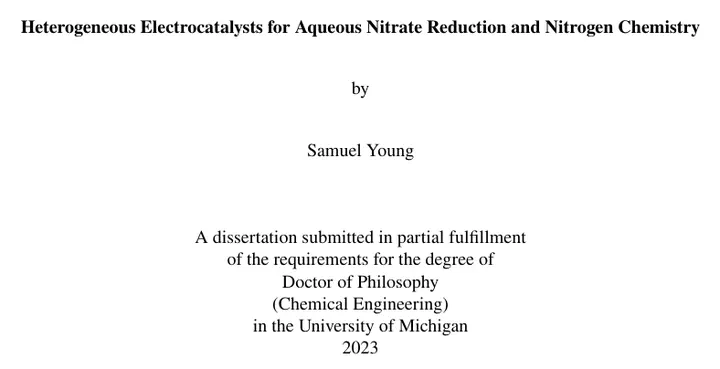Written Dissertation

Abstract
Humans contribute more fixed nitrogen than can be reduced naturally. Understanding nitrogen chemistry is essential to balancing the global nitrogen cycle. An imbalanced nitrogen cycle raises levels of nitrate (NO3–) in water. Nitrate-laden water is linked to infant methemoglobinemia and ovarian cancer in humans, and to eutrophication in water reservoirs. To denitrify water, we propose using the electrocatalytic nitrate reduction reaction (NO3RR). NO3RR sustainably removes nitrate from water and generates benign or value-added products, such as NH3 or N2. However, understanding the interconversion of NO3–, NH3, and N2 and developing new catalytic materials are critical to enabling this process. In this thesis, we explore new NO3RR electrocatalysts, including metal alloys, metal sulfides, and metal oxynitrides. Chapters II–IV focus on original research, Chapter I provides an introduction to nitrate reduction, and Chapter V provides conclusions and a future outlook.
In Chapter II, we study the NO3RR mechanism on Pt–Ru catalysts. We hypothesized that tuning the Pt–Ru alloy composition will maximize the NO3RR rate by changing the NO3– and H adsorption strengths. We find Pt78Ru22/C in particular to be six times as active as Pt/C at 0.1 V vs. RHE. This maximum in activity arises from a transition in rate-determining step from nitrate dissociation to a different step at higher Ru content. This study demonstrates how electrocatalyst performance is tunable by changing the adsorption strength of reacting species through alloying.
In Chapter III, we study halide poisoning, a serious problem for many NO3RR electrocatalysts. Here we compare the NO3RR activity of rhodium sulfide (RhxSy) against Pt/C and Rh/C in the presence of chloride. We find that RhxSy is 1.6 to 5.6 times more active than Rh/C (the most active transition metal electrocatalyst) and 10 to 24 times more active than Pt/C over a potential range of 0 to 0.2 V vs RHE. In addition to being more active than Pt/C, RhxSy retains 63% of its activity in the presence of chloride. Sulfur vacancies in Rh3S4 terraces are predicted to be active for nitrate reduction via an H-assisted nitrate dissociation mechanism, but also bind chloride strongly. Our findings rationalize the experimentally observed high NO3RR activity but moderate chloride poison resistance of RhxSy/C.
In Chapter IV, we investigate the thermodynamic stability of perovskite oxynitrides (PONs), a promising class of ammonia synthesis electrocatalysts. We determine a prototypical stable anion ordering for both ABO2N and ABON2 stoichiometries containing a high degree of cis ordering between B cations and minority-composition anions. We predict 85 stable and 109 metastable PON compounds, with A = {La, Pb, Nd, Sr, Ba, Ca} and B = {Re, Os, Nb, Ta} forming PONs of less than 10 meV/atom above the thermodynamic convex hull. Computational Pourbaix diagrams for two stable candidates, CaReO2N and LaTaON2, suggest that not all compounds with zero energy above the thermodynamic convex hull can be easily synthesized.
Chapter V reviews the major findings of Chapters II–IV and discusses future research. We propose how machine learning studies can extend this dissertation’s work and accelerate discovery of new NO3RR electrocatalysts, including high-entropy and defected alloys, defected metal chalcogenides, and complex perovskites. Highly active, selective, and stable NO3RR electrocatalysts will help mitigate the ecological and health risks from the nitrogen cycle imbalance in an energy-efficient and economically viable way.